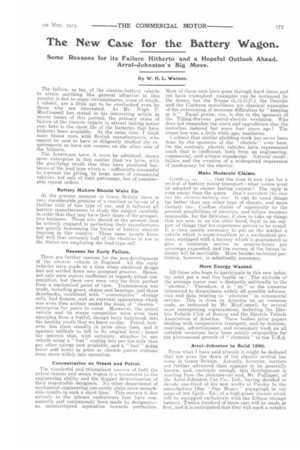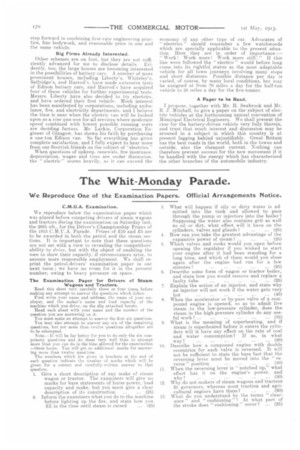The New Case for the Battery Wagon.
Page 5

Page 6

If you've noticed an error in this article please click here to report it so we can fix it.
Some Reasons for its Failure Hitherto and a Hopeful Outlook Ahead. Arrol-Johnston' s Big Move.
By W. H, L. Watson.
The failure, so far, of the electric-battery vehicle to attain anything like general adoption in this country is due to many circumstances, some of which. I submit, are a little apt to be overlooked even by those who are interested. As Mr. Hugh P. MacConnell has stated in his interesting article in recent issues of this journal, the primary cause of failure of the electric vehicle to attract lasting notice over here is the short. life of the batteries that have hitherto been available. At the same time. I think some blame rests with British manufacturers, who cannot be said to have so diligently studied the requirements as have our cousins on the other side of the Atlantic.
The Americans have, it must be admitted, shown more enterprise in this matter than we have, with the gratifying result that they have produced batteries of the lead type which as sufficiently successful to warrant the giving, by large users of commercial vehicles, not only of their patronage, but of considerable repeat orders.
Battery Makers Should Wake Up.
At the present moment in Great Britain there is very considerable promise of a reaction in favour of a further trial of this type of car, and it behoves all battery manufacturers to study the subject carefully in order that they may have their share of the prospective business. Those who should at the present time be actively engaged in perfecting their manufactures are quietly bemoaning the future of battery electric traction in this country. These same people know full well that certainly half of the electries in use in the States are employing the lead-type cell.
Reasons for Early Failure.
There are further reasons for the non-development of the electric vehicle in England. All the early vehicles were made at a time when electrical design had not settled down into accepted grooves. Hence, not only were motors inefficient as regards actual consumption, but these cars were very far from perfect from a mechanical point of view. Transmission was crude, including gears, chains and bearings, and these drawbacks, combined with " consumptive " storage cells, bad finance, and an external appearance which was even then archaic sealed the doom of " electric " enterprise for years to come. Moreover, the petrol vehicle and its steam competitor were even then emerging from a fretful, though lusty babyhood, into the healthy youth that we know to-day. Petrol, however, has risen steadily in price since then. and it appears unlikely to fall to its original level ; hence the interest that, with certainty, attaches to any vehicle using a "fuel costing less per ton-mile than any other energy now available, and a " fuel " going lower and lower in price as electric power stations come more widely into operation.
Concentration on Steam and Petrol.
The wonderful and triumphant success of both the petrol chassis and steam wagon is a monument to the engineering ability and the dogged determination of their responsible designers. No other department of mechanical engineering can surely claim more remarkable results in such a short time. This success is due entirely to the intense endeavours that have consistently and continuously been made by designers— an uninterrupted aspiration towards perfection.
Most of these men have gone through hard times and yet have triumphed—examples can be instanced by the dozen, but the B-type (L.G.O.C.), the Daimler and the Clarkson motorbuses are classical examples of the overcoming of immense difficulties by "keeping at it." Equal praise, too, is due to the sponsors of the Tilling-Stevens petrol-electric evolution. Who does not remember the scorn and opprobrium that the motorbus induced but some four years ago ? The steam bus was, a little while ago, anathema.
I submit that similar plodding work has never been done by the sponsors of the " electric " over here. On the contrary, electric vehicles have represented much that is inefficient, both from an engineering, commercial, and artistic standpoint. Natural result : failure and the creation of a widespread impression of inadequacy for the electric.
Make Moderate Claims.
Grant,..,„ that the time is now ripe for a revival of battery motor transport—what means must be adopted to ensure lasting success ? The reply is even easier than the query. Don't over$tate the ease for the electric-battery car. It can do some things far better than any other type of chassis, and more cheaply too. Confine claims of superiority to the present possibilities of electrics, and failure becomes impossible, for the Britisher, if slow to take up things that are new, is. on the other band, loyal in his support of things that his experience proves to be sound. It is then merely necessary to put on the market a vehicle which is super-excellent as a mechanical product, equipped with a battery which is guaranteed to give a minimum service in ampere-hours per sovereign expended, and the success of the future industry will be inevitable. More besides technical perfection, however, is admittedly necessary.
More Energy Wanted.
All those who hope to participate in this new industry must get a real live hustle on The attitude of the average motor user is distinctly unfriendly to the " electric." Therefore, it is " up " to the concerns interested to disseminate widely all possible information and data relating to " electrics ' in commercial service. This is done in America on an immense scale, as indicated by Mr. MacConnell, by several most enterprizing organizations, including the Electric Vehicle Club of Boston and the Electric Vehicle Association of America. These bodies print papers dealing with comparative transport, and by lectures, meetings, advertisement, and missionary work on all suitable occasions have been mainly responsible for the phenomenal growth of " eleetries " in the U.S.A.
Arrol-Johnston to Build 1200.
From what T have said already it might be deduced that not even the dawn of the electric revival has come in Great Britain. Actually, however, matters are further advanced than appears to be generally known, and, curiously enough, this development is starting from the pleasure-ear end, Mr. Pullinger, of the Arrol-Johnston Car Co., Ltd.' having decided to
devote on k uric-third of his new work's at Paisley to the manufacture [See " One Hears " paragraph in our issue of 3rd April.En.] of a high-grade chassis which will be equipped exclusively with the Edison storage battery. Twelve hundred of these cars will be made at first, and it is anticipated that they will mark a notable
step forward in combining first-rate engineering practice, fine bodywork, and reasonable price in one and the same vehicle.
Big Firms Already Interested.
Other schemes are on foot, but they are not sufficiently advanced for me to disclose details. Evidently, too, the large houses are becoming interested in the possibilities of battery ears. A number of more prominent houses, including Liberty's, Whiteley's, Selfridge's, and Harrod's. have made extensive tests of Edison battery cars, and Harrod's have acquired four of these vehicles for further experimental tests. Messrs. Liberty have also decided to try electrics, and have ordered their first vehicle. Much interest has been manifested by corporations, including ambitlance, fire, and electricity departments, and I believe the time is near when the electric van will be looked upon as a sine qua non for all services where moderate speed combined with lowest possible running costs are deciding factors. Mr. Leckie, Corporation Engineer of Glasgow, has shown his faith by purchasing a one-ton Edison van, So far everything has given complete satisfaction, and I fully expect to hear more from our Scottish friends on the subject of "electrics."
When questions of upkeep. renewals, fire insurance. depreciation, wages and tires are under discussion. the " electric " scores heavily, as it can exceed the
economy of any other type of car. Advocates of " electrics " should remember a few watchwords which are specially applicable to the present situation. Here they are in order of importance :— "Work! Work more Work more still! " If this line were followed the " electric" would before long come into its rightful status as the most adaptable vehicle for all town journeys involving many stops and short distances. Possible distance per day is varied, of course, by many local conditions, but IDay be assigned at from 70 miles a day for the half-ton vehicle to 35 miles a day for the five-tonner.
A Paper to be Read.
I propose, together with Mr. IL Seabrook and Mr. It J. Mitchell, to give a paper on the subject of electric vehicles at the forthcoming annual convention of Municipal Electrical Engineers. We shall present the case for the battery-driven vehicle very fully therein, and trust that much interest and discussion may be aroused in a subject in which this country is at present lagging behind unjustifiably. Great Britain has the best roads in the world, both in the towns and outside, also the cheapest current. Nothing can therefore prevent success for the new movement if it be handled with the energy which has characterized the other branches of the automobile industry.


























